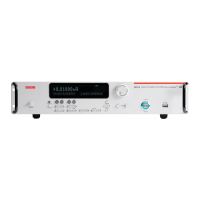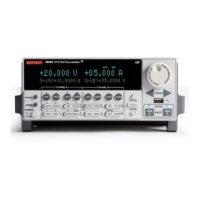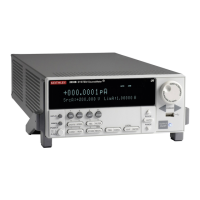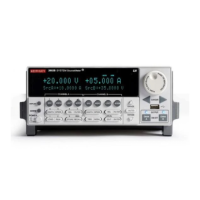D-28 Return to Section Topics 2600S-901-01 Rev. C / January 2008
Appendix D: Status Model Series 2600 System SourceMeter® Instruments Reference Manual
Error queue
The Error Queue holds error and status messages. When an error or status event occurs, a
message that defines the error or status is placed in the Error Queue.
When a message is placed in the Error Queue, the Error Available (EAV) bit in the Status Byte
Register is set. An error or status message is cleared from the Error Queue when it is read. The
Error Queue is considered cleared when it is empty. An empty Error Queue clears the EAV bit in
the Status Byte Register.
The commands to control the Error Queue are listed in Table D-10. When you read a single
message in the Error Queue, the oldest message is read and then removed from the queue. On
power-up, the Error Queue is initially empty. If there are problems detected during power-on,
entries will be placed in the queue. When empty, the error number 0 and “No Error” is placed in the
queue.
Messages in the Error Queue include a code number, message text, severity, and TSP-Link node
number. The messages are listed in
Table B-2.
Table D-10
Error queue commands
Error queue command Description
errorqueue.clear() Clear error queue of all errors.
errorqueue.count Number of messages in the error/event queue.
errorcode, message, severity,
node = errorqueue.next()
Request error code, text message, severity, and
TSP-Link node number.
TSP-Link system status
The TSP-Link is an expansion interface that allows the instruments to communicate with each
other. The test system can be expanded to include up to 64 TSP-Link-enabled instruments. In a
TSP-Link system, one node (instrument) is the Master and the other nodes are the Slaves. The
Master can control the other nodes (Slaves) in the system. See Section 9 for details on the
TSP-Link.
The system summary registers (shown in Figure D-1 and Figure D-2) are shared by all nodes in
the TSP-Link system. A status event that occurs at a Slave node can generate an SRQ (service
request) in the Master node. After detecting the service request, your program can then branch to
an appropriate subroutine that will service the request. See
"Status byte and service request
(SRQ)" in this appendix for details.
Status model configuration example
Figure D-9 shows an example status model configuration for a TSP-Link system. In this example,
a current limit (compliance) event in SMU A or SMU B of Node 15 will set the RQS bit of the Status
Byte of the Master Node. The commands to configure the status model for this example are
provided in “
"Status configuration (enable) commands"” in this appendix.
When a current limit (compliance) condition occurs in SMU A or SMU B of Node 15, the following
sequence of events will occur:
• Node 15 – Bit B1 or B2 of the Measurement Event Current Limit Summary register sets
when the current limit (compliance) event occurs.
• Node 15 – Bit B1 (ILMT) of the Measurement Event Register sets.
• Node 15 – Bit B0 (MSB) of the Status Byte sets.

